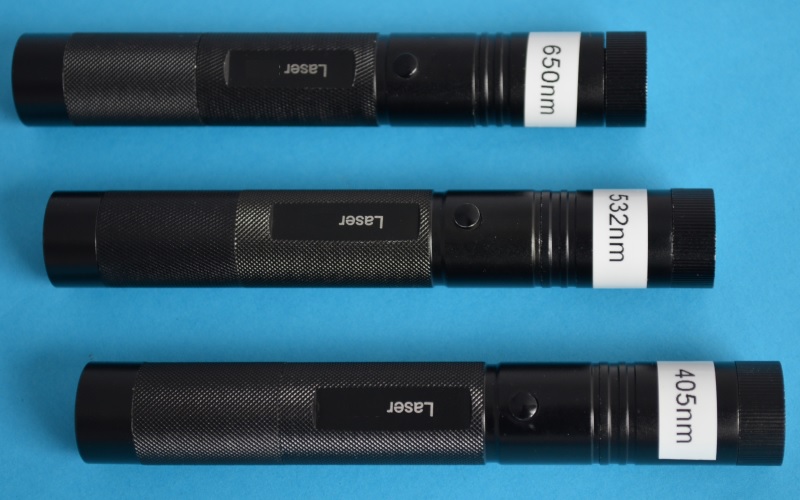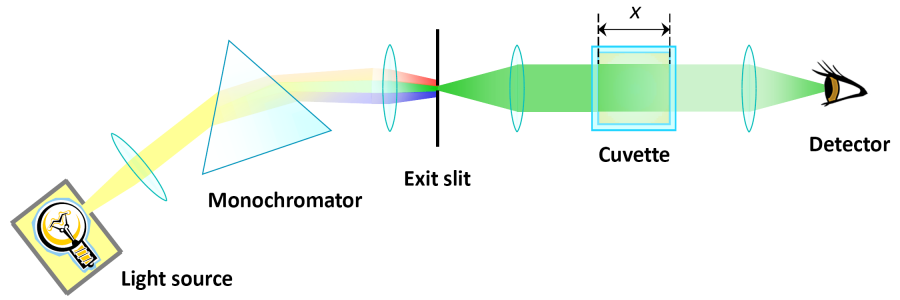Extra tips voor werkblad 4.1: Zelf een absorptiefotometer maken (1/4)
Vragen:
- Hoe kan de lay-out van een fotometer worden verbeterd ten opzichte van de informatie op werkblad 4.1?
- Welke meetfouten kunnen optreden en hoe kunnen deze worden verminderd of vermeden?
De lichtbron
- Het spectrum van een absorptiecoëfficiënt over een groot spectraal bereik moet worden bepaald.
Hiervoor is een breedbandige lichtbron nodig. Het licht wordt door een monochromator gescheiden in zijn spectrale delen. Halogeenlampen zijn de aangewezen lichtbronnen dankzij hun helderheid in het bereik van 500 tot 3000 nm. Hun helderheid is stabiel als ze worden gebruikt met een gestabiliseerde gelijkstroomvoeding. Gebruik op wisselstroom (met een transformator) of een niet-gestabiliseerde stekkeradapter is ongunstig: bij 50 Hz flikkeren halogeenlampen bij 100 Hz, omdat de gloeidraad bij elke halve golf wordt verwarmd en afgekoeld en de emissie afhankelijk is van de temperatuur van de gloeidraad. Dit kan de kwaliteit van de gemeten gegevens verminderen.
De helderheid van halogeenlampen in het blauwe bereik is laag en in het ultraviolet is deze afwezig. Fotometers in laboratoria gebruiken daarom naast halogeenlampen ook deuteriumlampen. Deuteriumlampen zenden licht uit op korte golflengten van 200 tot 450 nm, maar ze zijn relatief duur en vereisen een speciale voeding. Hun UV-straling is gevaarlijk voor het menselijk oog en de huid.
Als alternatief kun je de proeven beperken tot een kleiner aantal golflengtes. LED- of laserpointers zijn in dat geval handig omdat ze in de optische opstelling gemakkelijk door elkaar verwisseld kunnen worden. Dit moet wel op een reproduceerbare manier kunnen om toevallige meetfouten door onnauwkeurige uitlijning te voorkomen. Een monochromator is niet meer nodig. Hun helderheid is stabiel, maar afhankelijk van de temperatuur. De spectrale bandbreedte van LED's ligt tussen 10 nm in het infrarood en rood en ongeveer 50 nm in het blauw. Dit kan leiden tot systematische meetfouten bij stoffen met een sterk variabele absorptiekarakteristiek binnen de bandbreedte van een LED.
Witte LED's zijn in feite blauw uitstralende LED's: een deel van hun blauwe licht wordt door een fosfor omgezet in een brede emissieband bij groene, gele en rode golflengten, waardoor de indruk van wit wordt gegeven. Bij een wit licht uitstralende LED moet een monochromator worden gebruikt.
Laserpointers zijn (in tegenstelling tot LED's) zeer helder en hebben een zeer kleine spectrale bandbreedte. Hun straling wordt goed geparallelliseerd door een geïntegreerde lens. Dit is een groot voordeel omdat het de lens voor de cuvet en de monochromator overbodig maakt.


